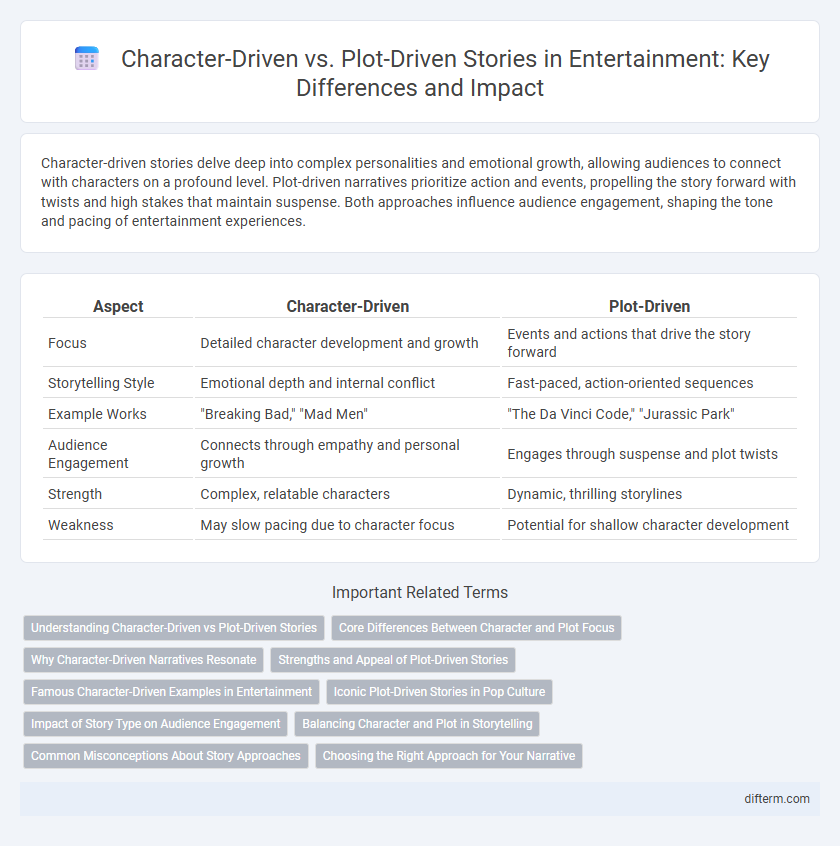Character-driven stories delve deep into complex personalities and emotional growth, allowing audiences to connect with characters on a profound level. Plot-driven narratives prioritize action and events, propelling the story forward with twists and high stakes that maintain suspense. Both approaches influence audience engagement, shaping the tone and pacing of entertainment experiences.
Table of Comparison
| Aspect | Character-Driven | Plot-Driven |
|---|---|---|
| Focus | Detailed character development and growth | Events and actions that drive the story forward |
| Storytelling Style | Emotional depth and internal conflict | Fast-paced, action-oriented sequences |
| Example Works | "Breaking Bad," "Mad Men" | "The Da Vinci Code," "Jurassic Park" |
| Audience Engagement | Connects through empathy and personal growth | Engages through suspense and plot twists |
| Strength | Complex, relatable characters | Dynamic, thrilling storylines |
| Weakness | May slow pacing due to character focus | Potential for shallow character development |
Understanding Character-Driven vs Plot-Driven Stories
Character-driven stories prioritize deep exploration of protagonists' motivations, emotions, and growth, creating an intimate connection between the audience and the characters. Plot-driven narratives emphasize a sequence of events, where external conflicts and actions propel the storyline forward, often focusing on twists and pacing. Understanding the balance between these approaches enhances storytelling by aligning character development with plot progression for maximum emotional and narrative impact.
Core Differences Between Character and Plot Focus
Character-driven stories emphasize deep psychological development and emotional arcs, making protagonists' motivations and transformations central to the narrative. Plot-driven stories prioritize sequences of events and external conflicts that propel the narrative forward, often relying on action and twists to maintain engagement. Core differences lie in character focus shaping the story's emotional depth, whereas plot focus structures the progression through cause-and-effect events.
Why Character-Driven Narratives Resonate
Character-driven narratives resonate because they create emotionally complex protagonists whose internal struggles mirror real human experiences, enhancing audience empathy and connection. These stories prioritize psychological depth and transformation over external events, fostering a sense of authenticity that drives engagement. By exploring nuanced motivations and moral dilemmas, character-driven tales offer rich, relatable journeys that leave lasting emotional impact.
Strengths and Appeal of Plot-Driven Stories
Plot-driven stories excel in delivering fast-paced, action-packed narratives that keep audiences deeply engaged through suspense and dynamic events. Their clear structure and external conflicts create a compelling momentum that appeals to viewers seeking thrilling, visually stimulating entertainment. This approach emphasizes the progression of events, providing a gripping framework that drives the story forward effectively.
Famous Character-Driven Examples in Entertainment
Iconic character-driven stories like "Breaking Bad" showcase complex protagonists whose personal evolution drives the narrative, emphasizing psychological depth over intricate plot mechanics. In "The Sopranos," Tony Soprano's internal conflicts and relationships fuel the drama, making character development the core of the show's appeal. These examples highlight how character-centric storytelling creates emotional engagement and lasting impact in entertainment.
Iconic Plot-Driven Stories in Pop Culture
Iconic plot-driven stories in pop culture, such as *Inception* and *The Matrix*, emphasize intricate narratives that propel the story forward through high-stakes conflicts and elaborate twists. These stories captivate audiences by prioritizing dynamic events and strategic developments over deep character exploration, creating immersive worlds where the plot's momentum remains paramount. The success of plot-driven entertainment often hinges on meticulously crafted scenarios that maintain suspense and deliver satisfying resolutions.
Impact of Story Type on Audience Engagement
Character-driven stories deepen audience engagement by fostering emotional connections through complex personalities and personal growth, making viewers more invested in the unfolding narrative. Plot-driven narratives prioritize dynamic events and suspense, capturing attention through fast-paced action and intriguing twists that maintain high levels of excitement. The story type directly influences audience retention, with character-driven tales encouraging empathy and reflection, while plot-driven works stimulate adrenaline and curiosity.
Balancing Character and Plot in Storytelling
Balancing character and plot in storytelling enhances narrative depth and audience engagement, ensuring characters' motivations drive the storyline while plot events challenge and evolve their development. Strong character arcs provide emotional resonance, making plot twists more impactful and meaningful. Integrating character-driven moments with plot-driven pacing creates a cohesive, compelling entertainment experience that resonates with viewers.
Common Misconceptions About Story Approaches
Many believe character-driven stories lack engaging plots, but strong characters often drive compelling narratives through internal conflict and growth. Conversely, plot-driven tales are not devoid of depth; they use external events to reveal character motivations and transformations. Understanding that both approaches intertwine enhances appreciation of storytelling complexity in entertainment.
Choosing the Right Approach for Your Narrative
Choosing between character-driven and plot-driven narratives hinges on the story's core purpose; character-driven tales prioritize deep psychological development and emotional arcs, enhancing audience empathy and connection. Plot-driven narratives emphasize a sequence of events and external conflicts, creating suspense and momentum that appeal to readers seeking action and resolution. Aligning your narrative approach with the intended emotional impact and pacing requirements ensures a compelling and coherent storytelling experience.
character-driven vs plot-driven Infographic

 difterm.com
difterm.com